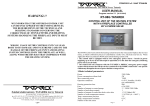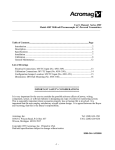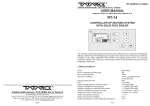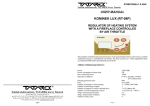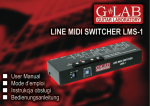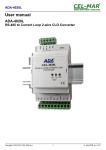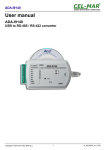Transcript
Zakład elektroniczny TATAREK Jerzy Tatarek Zakład elektroniczny TATAREK Jerzy Tatarek USER MANUAL OF TEMPERATURE SENSOR (THERMOCOUPLE TYPE K) USER MANUAL OF TEMPERATURE SENSOR (THERMOCOUPLE TYPE K) 20-40300088-0150 20-40300088-0150 The temperature sensor is designed for measuring the temperature of flue gas. The theoretical range of temperatures: 0-1200oC The usable temperature: max 1000oC (limited by Your controller) The precision: class I acc.to DIN EN 60584-2 The temperature sensor is designed for measuring the temperature of flue gas. The theoretical range of temperatures: 0-1200oC The usable temperature: max 1000oC (limited by Your controller) The precision: class I acc.to DIN EN 60584-2 You have to comply with the following rules: You have to comply with the following rules: While mounting: While mounting: 1.The marker should unconditionally be placed outside the installation, that is, outside the mounting place) 2. The cable shouldn’t be run close to the hot wall of the flue/pipe/chimney-should be run as far away from any heat source as possible (the cable has a temperature resistance of up o to 400 C). 3.Unconditionally you have to avoid mounting in areas of possible influences of the flame (the sensor mustn’t be mounted close to the flue gas output of a chimney or a stove). Otherwise it may lead to a premature failure of the sensor. 1.The marker should unconditionally be placed outside the installation, that is, outside the mounting place) 2. The cable shouldn’t be run close to the hot wall of the flue/pipe/chimney-should be run as far away from any heat source as possible (the cable has a temperature resistance of up o to 400 C). 3.Unconditionally you have to avoid mounting in areas of possible influences of the flame (the sensor mustn’t be mounted close to the flue gas output of a chimney or a stove). Otherwise it may lead to a premature failure of the sensor. While using: While using: * You have to be very careful while cleaning up the chimney/pipe and such. - in order to not cause a mechanical damage of the sensor. * It’s very recommended that the sensor should operate in a straight position, although in special cases you can bend the measuring part or behind the marker. You have to avoid bending at extreme angles. * You have to be very careful while cleaning up the chimney/pipe and such. - in order to not cause a mechanical damage of the sensor. * It’s very recommended that the sensor should operate in a straight position, although in special cases you can bend the measuring part or behind the marker. You have to avoid bending at extreme angles. *** Not complying with the rules may lead to decreasing the precision and a shorter life of the sensor. Wrong mounting and using of the sensor makes the warranty void. *** Not complying with the rules may lead to decreasing the precision and a shorter life of the sensor. Wrong mounting and using of the sensor makes the warranty void.
